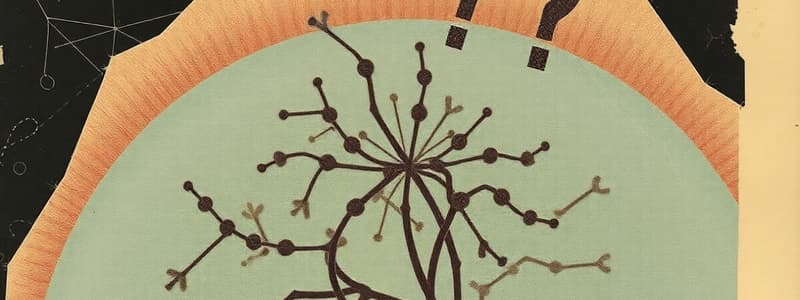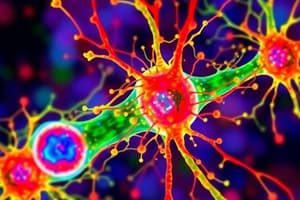Podcast
Questions and Answers
What is the primary role of microtubules during cell division?
What is the primary role of microtubules during cell division?
- They play a role in lipid synthesis during cytokinesis.
- They provide structural support to the cell membrane.
- They facilitate the movement of the nucleus to the cell periphery.
- They are involved in the formation of spindle fibers. (correct)
Which of the following correctly describes the composition of microtubules?
Which of the following correctly describes the composition of microtubules?
- They are formed from single protein strands without any subunits.
- They consist of multiple identical protein units arranged in a ring.
- They are composed of heterodimers of α- and β-tubulin. (correct)
- They are made exclusively from actin proteins.
What type of junction primarily allows for communication between adjacent cells?
What type of junction primarily allows for communication between adjacent cells?
- Adhering junctions
- Gap junctions (correct)
- Desmosomes
- Tight junctions
What is the diameter range of microtubules?
What is the diameter range of microtubules?
What structure do centrioles primarily contribute to in animal cells?
What structure do centrioles primarily contribute to in animal cells?
What is the primary arrangement of microtubules within a centriole?
What is the primary arrangement of microtubules within a centriole?
What structure is located at one end of the mature centriole?
What structure is located at one end of the mature centriole?
How do centrioles typically duplicate prior to cell division?
How do centrioles typically duplicate prior to cell division?
What is the role of the centrosome in cellular structure?
What is the role of the centrosome in cellular structure?
What is the characteristic structural configuration of a centriole described as '9 - 3'?
What is the characteristic structural configuration of a centriole described as '9 - 3'?
What are spot desmosomes primarily responsible for?
What are spot desmosomes primarily responsible for?
What is the key difference between spot desmosomes and hemidesmosomes?
What is the key difference between spot desmosomes and hemidesmosomes?
What is the pore size of the hydrophilic channel formed by gap junctions?
What is the pore size of the hydrophilic channel formed by gap junctions?
What protein forms the transmembrane components of gap junctions?
What protein forms the transmembrane components of gap junctions?
How do gap junctions contribute to cardiac muscle function?
How do gap junctions contribute to cardiac muscle function?
What is the primary protein that microfilaments are largely formed of?
What is the primary protein that microfilaments are largely formed of?
Which type of intermediate filament is primarily found in nerve axons?
Which type of intermediate filament is primarily found in nerve axons?
What is the typical diameter range of intermediate filaments?
What is the typical diameter range of intermediate filaments?
How are microfilaments primarily organized within cells?
How are microfilaments primarily organized within cells?
Which type of protein is found within Type III intermediate filaments?
Which type of protein is found within Type III intermediate filaments?
Which structure is typically produced by microfilaments?
Which structure is typically produced by microfilaments?
What is the structural arrangement of motile cilia?
What is the structural arrangement of motile cilia?
Intermediate filaments can be described as having which of the following characteristics?
Intermediate filaments can be described as having which of the following characteristics?
What primarily serves as the nucleation site for microtubules in the centrosome?
What primarily serves as the nucleation site for microtubules in the centrosome?
Which type of junction acts as a principal mechanical interlink between cells?
Which type of junction acts as a principal mechanical interlink between cells?
What is the typical width of the intercellular space separating cells in tissues?
What is the typical width of the intercellular space separating cells in tissues?
Which type of cadherin is specifically associated with epithelial cells?
Which type of cadherin is specifically associated with epithelial cells?
What is a consequence of cadherin loss during cancer development?
What is a consequence of cadherin loss during cancer development?
Which type of cell junction is characterized by sealing adjacent cells together to prevent the passage of materials?
Which type of cell junction is characterized by sealing adjacent cells together to prevent the passage of materials?
What links cadherins to the cytoskeleton in adherens junctions?
What links cadherins to the cytoskeleton in adherens junctions?
Which type of junction allows for direct communication between adjacent cells?
Which type of junction allows for direct communication between adjacent cells?
Study Notes
Cytoskeleton
- Animal cells maintain their three-dimensional structure through a network called the cytoskeleton
- The cytoskeleton is made up of three main components: microtubules, microfilaments, and intermediate filaments
- All three components are assembled from cytoplasmic proteins.
Microtubules
- Microtubules are hollow cylinders with a diameter of 25-30nm
- They are composed of 13 subunits arranged in a left-handed helix
- Each subunit is a heterodimer of two proteins: alpha- and beta-tubulin
- They are the thickest filaments and are rigid
- They have a + and a - end
Function of Microtubules
- They form the axoneme of cilia and flagella
- They form the components of centrioles
- They form the spindle fibers during cell division
- They are involved in intracellular movement in nerve cell axons
Microtubules: Motile vs Non-Motile
- Motile microtubules have a 9+2 structure and are found in cilia and flagella
- Non-motile microtubules have a 9+0 structure and are found in primary cilia, such as those in kidney cells.
Microfilaments
- Also known as Actin filaments
- Solid filaments with a diameter of 5-7nm
- Primarily composed of the protein actin
- Found in most animal cells and some plants cells
- Concentrated in networks or bundles just below the plasma membrane
- Involved in forming intestinal microvilli
Intermediate Filaments
- Heterogeneous in composition: Each cell will have more than one type, with one usually dominating
- Five main types based on the protein involved:
- Type I & II - keratins (acidic and basic)
- Type III - vimentin-like proteins (found in cells of mesodermal origin)
- Type IV - neurofilaments (found in nerve axons)
- Type V - nuclear laminins (form the nuclear lamina)
- Rope-like filaments found in most cells
- Size intermediate to actin filaments and microtubules
- Solid filaments with a diameter of 7-11nm
- Non-alpha-helical (globular) domain at the N and C-termini, surrounding the alpha-helical rod domain.
Centrioles
- Found in all animal cells and ciliated plant cells
- Located in the cytoplasm, near the nucleus
- Often associated with the Golgi apparatus
- The area where they are found is called the microtubule organizing centre
- Typically two cylindrical structures arranged at right angles to each other
Centrioles: Structure
- Composed of 9 sets of triplets arranged in a cylinder.
- Known as a 9x3 structure (9+0 structure)
- Each triplet consists of three microtubules:
- Set A is complete.
- Set B and C share portions of their walls.
- A cartwheel structure is found at one end of the centriole, protruding from the outer surface at the proximal end of a mature centriole.
- Fibrous structures connect the two centriole cylinders.
Centrioles: Function
- Centrioles replicate and move to opposite poles of the cell before cell division
- New daughter centrioles grow at right angles to the 'old' centriole
- One new centriole and one old centriole form areas known as centrosomes.
Centrosomes
- The centrosome is the main microtubule organizing centre of the cell.
- Composed of two orthogonally arranged centrioles
- Contain pericentriolar material (purple), responsible for microtubule nucleation and anchoring
Centrosomes: Microtubule Organization
- Microtubules radiate from the centrosome, but they are not organized by the centrioles.
- Microtubules originate from gamma-tubulin rings in the centrosomal matrix (distal appendages).
- Each gamma-tubulin ring acts as a nucleation site for one microtubule.
- An aster of microtubules forms the visible spindle fibers during cell division.
- Some spindle fibers bind to the chromosomes at the centromere.
Cell Junctions
- Most cells in tissues are attached to other cells.
- Cells are separated by an intercellular space of 20-30nm.
- Specialized intercellular junctions maintain more direct contact between membranes.
- Three types of cell junctions exist:
- Adhesion Junctions (Adherens and Desmosomes)
- Tight Junctions
- Gap Junctions
Adhesion Junctions
- Principle mechanical interlinks between cells, serving as strong connections between epithelial cells.
- Two types:
- Desmosomes
- Adherens junctions
- The intercellular space is normal (30nm) and filled with transmembrane proteins called cadherins.
Cadherins
- Form links to cytoplasmic structures.
- Connect the membrane to the cytoskeleton
- Three types:
- E-cadherin – epithelial
- N-cadherin – neuronal
- P-cadherin – placental
- Cadherin loss is associated with cancer and metastases.
Adherens Junctions
- Cadherin attachment occurs via linker proteins to actin microfilaments in the cytoplasm.
- Serve as a bridge connecting the actin cytoskeleton of neighboring cells.
Desmosomes
- Disc-like plaques in the cytoplasm, 20nm thick and 0.2-0.3µm in diameter.
- Two types:
- Spot desmosomes (Macula adherens), which are like spot rivets connecting cells via intermediate filaments.
- Hemidesmosomes connect the bottom surface of epithelial cells to the underlying basal lamina.
- The transmembrane linker proteins in hemidesmosomes are integrins.
Hemidesmosomes
- Integrins are the transmembrane linker proteins in hemidesmosomes.
Gap Junctions
- Involved in the interchange of small inorganic ions and molecules between adjacent cells.
- The intercellular space is reduced to 2-4nm.
- Each membrane contains a hexagonal array of proteins.
- The transmembrane proteins are called connexins.
Gap Junctions: Structure
- Arrays in opposing membranes align.
- This forms a hydrophilic channel with a pore size of 1.5nm in diameter.
- Gap junctions are associated with intercalated discs in cardiac muscle, facilitating the transmission of electrical impulses.
Studying That Suits You
Use AI to generate personalized quizzes and flashcards to suit your learning preferences.
Related Documents
Description
Explore the structure and function of the cytoskeleton, focusing on microtubules in animal cells. This quiz covers microtubule composition, their roles in cell division, and distinctions between motile and non-motile microtubules. Test your knowledge on the essential components that maintain cellular integrity and movement.




